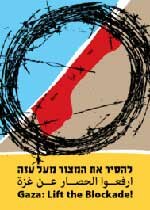By Amira Hass, Haaretz – 17 Oct 2012
www.haaretz.com/news/diplomacy-defense/2-279-calories-per-person-how-israel-made-sure-gaza-didn-t-starve.premium-1.470419
Israel forced to release ‘red lines’ document for food consumption in the coastal Strip following legal battle; official: state has right to determine who it assists.
After a three-and-a-half-year legal battle waged by the Gisha human rights organization, the Coordinator of Government Activities in the Territories has finally released a 2008 document that detailed its “red lines” for “food consumption in the Gaza Strip.”
The document calculates the minimum number of calories necessary, in COGAT’s view, to keep Gaza residents from malnutrition at a time when Israel was tightening its restrictions on the movement of people and goods in and out of the Strip, including food products and raw materials. The document states that Health Ministry officials were involved in drafting it, and the calculations were based on “a model formulated by the Ministry of Health … according to average Israeli consumption,” though the figures were then “adjusted to culture and experience” in Gaza.
COGAT, appealing a District Court ruling to release the document, stated that it was merely a rough draft, that it was never actually implemented, and that it did not guide Israeli policy in practice. In its objection to the document’s publication, COGAT argued that there was no reason to disclose what was essentially internal staff work, a mere proposal that was never actually put into effect. In fact, COGAT told Haaretz on Tuesday, after the document was drafted, the agency never even held a single discussion of it.
But the court disagreed, and on its orders, the document (in two different versions, both from January 2008) was given to Gisha two weeks ago. It is now being published here for the first time. Its very existence was also first reported in Haaretz, in a June 2009 article by Uri Blau and Yotam Feldman.
In September 2007, the cabinet, then headed by Prime Minister Ehud Olmert, decided to tighten restrictions on the movement of people and goods to and from the Gaza Strip. The “red lines” document was written about four months afterward.
The cabinet decision stated that “the movement of goods into the Gaza Strip will be restricted; the supply of gas and electricity will be reduced; and restrictions will be imposed on the movement of people from the Strip and to it.” In addition, exports from Gaza would be forbidden entirely. However, the resolution added, the restrictions should be tailored to avoid a “humanitarian crisis.”
At a High Court hearing on Gisha’s petition against this policy, government attorneys Gilad Sherman and Dana Briskman, backed by an affidavit from Col. Shlomi Mukhtar of COGAT, explained that “it is the state’s right to decide that it doesn’t intend to have economic ties with, or provide economic assistance to, the other party in the conflict, and to adopt a policy of ‘economic warfare.’”
The “red lines” document calculates the minimum number of calories needed by every age and gender group in Gaza, then uses this to determine the quantity of staple foods that must be allowed into the Strip every day, as well as the number of trucks needed to carry this quantity. On average, the minimum worked out to 2,279 calories per person per day, which could be supplied by 1,836 grams of food, or 2,575.5 tons of food for the entire population of Gaza.
Bringing this quantity into the Strip would require 170.4 truckloads per day, five days a week.
From this quantity, the document’s authors then deducted 68.6 truckloads to account for the food produced locally in Gaza mainly vegetables, fruit, milk and meat. The documents note that the Health Ministry’s data about various products includes the weight of the package (about 1 to 5 percent of the total weight) and that “The total amount of food takes into consideration ‘sampling’ by toddlers under the age of 2 (adds 34 tons per day to the general population).”
From this total, 13 truckloads were deducted to adjust for the “culture and experience” of food consumption in Gaza, though the document does not explain how this deduction was calculated.
While this adjustment actually led to a higher figure for sugar (five truckloads, compared to only 2.6 under the Health Ministry’s original model),
it reduced the quantity of fruits and vegetables (18 truckloads, compared to 28.5), milk (12 truckloads instead of 21.1), and meat and poultry (14 instead of 17.2).
Altogether, therefore, COGAT concluded that Israel needed to allow 131 truckloads of food and other essential products into Gaza every day (via the “back to back” system, in which goods are transferred from an Israeli truck to a Palestinian one at the border). Of these, 106 would go through the Kerem Shalom crossing and the rest via the Karni crossing (which was closed a few years later).
The document states that then-Deputy Defense Minister Matan Vilnai had approved the entry of 106 trucks per day even before the “red lines” were calculated, along with additional truckloads of wheat seed and animal feed.
The point of the “red lines” document was to see if this number of trucks in fact met Gaza’s needs. But according to Gisha, UN data shows that the number of trucks allowed into Gaza each day often fell below this level.
COGAT, then headed by Maj. Gen. Amos Gilad, translated the government’s policy of restrictions into two lists. The long one detailed the forbidden goods that couldn’t be brought into the Strip (including, for example, building materials, needles, cloth and other raw materials, cleaning and bathing supplies, books, musical instruments and processed hummus). The short one listed those that could be brought in. The guiding principle was that instead of the supply of goods being dictated by demand, it would be dictated by the quantities and varieties deemed necessary by COGAT.
From time to time, COGAT officers revised the lists. Thus in late 2008, for instance, COGAT began allowing the import of shampoo though conditioner was still banned. In 2009, plain processed hummus was taken off the banned list, but hummus with pine nuts was still off-limits.
To obey the cabinet’s order to avoid a “humanitarian crisis,” COGAT officers devised what they called “sensors” to warn them if there was a risk of impending malnutrition or an impending shortage of the permitted goods. Thus in addition to the “red lines,” they produced two other documents: a model for estimating inventories of essential staples in Gaza, and a procedure for allowing the entry of goods into the Strip.
In practice, COGAT says, policy was guided by the inventory estimation model and the procedure for the entry of goods, not by the “red lines” document.
Following another petition to the High Court by Gisha, these two documents were published by Haaretz in October 2010.
“The quantification wasn’t done in order to arrive at a minimum threshold or restrict the quantities, but the opposite to ensure that there was no shortage,” a COGAT official maintained Tuesday.
Gisha, however, doubts the claim that the “red lines” document was never actually used. For instance, it said, the prosecution evidently relied on the minimum threshold the document sets for meat (300 calves imported each week) when it argued in court against Gisha’s request that the quota be increased during the Eid al-Fitr holiday, at the end of Ramadan. COGAT responded that this particular figure was part of the inventory estimation model, and therefore that it was in use.
International humanitarian organizations use a model called the Sphere standards to gauge a population’s needs and determine the aid that should be sent to it in an emergency (whether war or natural disaster). This model is far more complex and less mathematical than the “red lines.” But the most significant difference is that the “red lines” and the inventory estimation model were both devised by the very party that deliberately created the emergency situation, and that effectively controls both the territory and the population.
The drafters of the “red lines” document noted that the quantity of fruit and vegetables Gaza could produce for itself was expected to decline from 1,000 tons a day to 500 within a few months, due to the Israeli ban on bringing in seeds and other raw materials needed for agriculture, as well as the ban on exporting produce from the Strip. They predicted a similar fate for the poultry industry. But they didn’t propose any solution for this decline.
Robert Turner, UNRWA’s director of operations in the Gaza Strip, told Haaretz that he “read the draft with concern. If this reflects an authentic policy intended to cap food imports, this ‘red lines’ approach is contrary to humanitarian principles. If it is intended to prevent a humanitarian crisis by setting a minimum threshold, it has failed.”
UNRWA, as the UN agency responsible for aiding Palestinian refugees, is closely involved in the daily lives of some 1 million residents of the Gaza Strip. Based on this knowledge, Turner asserted that “The facts on the ground in Gaza demonstrate that food imports consistently fell below the red lines.
Had official crossings been the only channel of food imports in the Gaza Strip and UN agencies not ensured that a minimal share of food reached the poorest, the recorded level of imports would have resulted in a substantial aggravation of nutritional deficiencies in the Gaza Strip.”
Moreover, he said, the model failed to take into account the food lost due to the “back to back” trucking system: Sacks of food routinely break open and spill as they are being transferred from one truck to the other. This loss alone, Turner said, cost UNRWA about $5 million a year.
Asked whether the situation in Gaza is better today, now that the ban on the entry of food and most other goods has been lifted, Turner said that as long as the ban on exports remains in force, the “unprecedented levels of ‘man made’ aid dependency” will remain in force as well.
Attorney Sari Bashi of Gisha said Israel’s claim that it isn’t responsible for Gaza’s population is clearly in contradiction with the fact that “it can determine the amount and types of food that will be found in the markets. This control obligates it to refrain from restrictions on movement that don’t answer a concrete security need an obligation that isn’t being met by the current policy.”
The Health Ministry did not respond to Haaretz’s questions about its involvement in writing the document.
- Tweet

Please support the IOA so that we can continue covering the Israeli Occupation. To help, please CLICK HERE







































{ 0 comments… add one now }